
About UsThe Numismatic Bibliomania Society is a non-profit organization promoting numismatic literature. For more information please see our web site at coinbooks.org SubscriptionsThose wishing to become new E-Sylum subscribers (or wishing to Unsubscribe) can go to the following web page link MembershipThere is a membership application available on the web site Membership Application To join, print the application and return it with your check to the address printed on the application. Membership is only $15 to addresses in the U.S., $20 for First Class mail, and $25 elsewhere. For those without web access, write to: David M. Sundman, Secretary/TreasurerNumismatic Bibliomania
Society AsylumFor Asylum mailing address changes and other membership questions, contact David at this email address: dsundman@LittletonCoin.com SubmissionsTo submit items for publication in The E-Sylum, just Reply to this message, or write to the Editor at this address: whomren@coinlibrary.com
BUY THE BOOK BEFORE THE COINYou won't regret it! |
- WAYNE'S WORDS: THE E-SYLUM JUNE 24, 2012
- NEW BOOK: THE MEDAL-OF-THE-MONTH CLUB
- NEW BOOK: 2013 STANDARD CATALOG OF WORLD COINS 1901-2000
- NEW BOOK: COINS OF INDIA: SPECIALIZED STUDY 1835-2012
- NEW BOOK: DECORATIONS OF SOCIALIST ALBANIA
- MORE ON THE PAPER CURRENCY OF TIBET BOOK
- NEW BOOK: ATTILIO STAZIO: SCRITTI DI NUMISMATICA
- BOOK REVIEW: MONUMENTAL MONEY: PEOPLE AND PLACES ON U.S. PAPER MONEY
- BOOK REVIEW: FRENCH MEDALLIC ART: 1870-1940
- SUPPORT THE AMERICAN NUMISMATIC SOCIETY LIBRARY
- NUMISMATIC NEWS HITS 60TH ANNIVERSARY MILESTONE
- "THE CALIFORNIA NUMISMATIST" AVAILABLE FREE ONLINE
- ON THE FIRST EDITION OF RAYMOND'S STANDARD CATALOGUE OF U.S. COINS
- A RELIC MEDAL OF THE GERMAN SUBMARINE DEUTSCHLAND
- "HONEY, I HID THE COIN COLLECTION!"
- BENEFACTOR PURCHASES AND LENDS HISPANIC COINS TO THE ANS
- DICK JOHNSON OFFERS NEW BOOKS ON MEDAL TOPICS
- MORE ON MICHAEL ANNIS
- NOTES FROM E-SYLUM READERS: JUNE 24, 2012
- QUERY: NAMED WOODWARD OCTOBER 1864 SALE SOUGHT
- ALAN WEINBERG ON ORGANIZED COIN DEALER THEFTS
- STOLEN DOCUMENTS AND MEDALS RETURNED TO CHICAGO'S POLISH MUSEUM
- ART AND VICTOR DAVID BRENNER TAKE ON TIMES SQUARE
- WHY CASH IS LOSING ITS CURRENCY
- WAYNE'S NUMISMATIC DIARY: JUNE 24, 2012
- GOLD EXHIBITION AT LONDON'S GOLDSMITHS' HALL
- QUERY: "IN GOOD NICK"
- ALEKSEY NAVALNY'S RUSSIAN BANKNOTE STAMPS
- WHERE MONEY GOES TO DIE
- SOME NEW COIN DESIGNS: LITHUANIA AND SLOVAKIA
- SCHOLARS FEAR LAWSUITS IN DECLARING WORKS REAL OR FAKE
- BULGARIAN ARCHAEOLOGISTS DISCOVER BRONZE COIN TREASURE
- FEATURED WEB PAGE: COINS OF ALBANIA
WAYNE'S WORDS: THE E-SYLUM JUNE 24, 2012

New subscribers this week include Ron Regina, Virginia Smith, L. Grove, Jeff Hawk, Tom Garver, William Mitchell and Mr. Anh. Welcome aboard! We have 1,561 email subscribers, plus 181 followers on Facebook.
This week we have a whopper of an issue. We open with information on six numismatic books followed by reviews of two more. Other topics include the ANS/Hispanic Society coins, organized coin dealer thefts, Numismatic News' 60th anniversary, and a new exhibit on Gold.
To learn more about the Medal of the Month Club, French Art Medals, a German U-Boat, Victor David Brenner on Times Square, Russian banknote stamps and the Decorations of Socialist Albania , read on.
Have a great week, everyone!
NEW BOOK: THE MEDAL-OF-THE-MONTH CLUB
 THE MEDAL-OF-THE-MONTH CLUB
THE MEDAL-OF-THE-MONTH CLUB
Created by Felicity Buranelli
Compiled by Harry Waterson
This is a Catalogue Raisonné of the medals and emblems commissioned by Felicity Buranelli from 1939 to 1972. During that time she issued 10 medals and 2 emblems under the umbrella title THE MEDAL-OF-THE-MONTH CLUB. This catalogue tells the story of Miss Buranelli and the stories of the medals she issued.
Miss Buranelli did not have exclusive use of her title. At one time the Lincoln Mint had THE MEDAL OF THE MONTH SOCIETY which actually issued a medal a month. There was also a medal dealer in Sioux Falls, SD who had a MEDAL OF THE MONTH CLUB. He sold commemoratives, medals and tokens of his choice under the Medal-Of-The-Month name. There were others who also used the term so confusion abounds.
This particular club was the creation of Felicity Buranelli (1893-1979). She began work on it in the 1930s and it was to occupy her for the rest of her life. Her intention was to create a series of medals that would inspire the youth of America. She wanted medals that would depict the lives of great men and women who have made and are still making the history of America and preserving Democracy.
Her first series of medals commemorated the lives of the pioneers of aviation. She intended to then go on to additional series honoring heroes from other fields of endeavor in America. She never got past aviation. She began to issue her Aviation Series in 1941 with a run of four medals. The attempt at a monthly issue quickly faltered and she continued to issue medals on a very intermittent basis until 1962 when she released her eighth medal honoring John Glenn and then she disbanded her club. Later she issued two more medals that served as memorials; one in honor of her brother who was an innovative aircraft designer and one for a Jesuit priest who had had a large impact on her life. The entire ten-medal run spanned 31 years from 1941 to 1972.
Buranelli described her aviation heroes as all having exhibited Courage, Vision and untiring Work. These three words were her inspirational mantra for the youth of America. She used COURAGE, VISION and WORK as the legend on the emblems she had designed for the boys and girls of her club to wear. These two emblems are also included in this Catalogue Raisonné.
The Medal-Of-The-Month Club was Felicity Buranelli. She chose the subjects. She picked the artists and gave them their direction. She wrote the copy for the reverse of the medals. She supervised the production of the medals and she was in charge of advertising and promotion. She held all the copyrights but one. She raised the money and she was her only distributor. She was very proud of the fact that she did this all herself and had not allowed crass commercialism to enter into any phase of her program. The process was very slow and painstaking but the medals she produced were remarkable. Not so her success as a business woman and entrepreneur. She was still selling these medals out of her Manhattan apartment as late as 1976.
This soft-cover monograph is 82 pages long. It is in 8 1/2x11-inch format with 22 pages of color. The catalogue will answer the question; what took her so long?
NEW BOOK: 2013 STANDARD CATALOG OF WORLD COINS 1901-2000
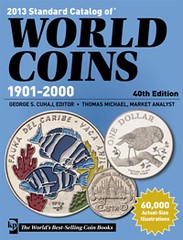 The 2013 Standard Catalog of World Coins 1901-2000 is now available from Krause Publications.
The 2013 Standard Catalog of World Coins 1901-2000 is now available from Krause Publications.
Edited by world coin experts George Cuhaj and Tom Michael, this top-selling, one-of-a-kind coin guide contains nearly 1 million values for coins minted around the world between 1901 and 2000. With few exceptions, the values stated in this new 40th edition have risen from the previous year, and in some cases, the values have increased substantially -- based on market demand. Cuhaj and Michael worked with more than 200 experts worldwide to compile information for this volume.
In addition to current values, this book also contains 60,000 actual-size illustrations of coins -- including the obverse and reverse. These illustrations are great for helping to accurately identify coins -- an essential part of grading and pricing coins.
With listings for gold, platinum, palladium and silver coins, this 2,400-page book also helps readers chart a course of success in today's turbulent precious metals market by providing:
-Total coin weight
-Fineness
-Actual precious metal content
Collector coins, sets, trial strikes, pieforts, patterns, token issues and more are featured in the 40th edition of the Standard Catalog of World Coins 1901-2000.
The 2013 Standard Catalog of World Coins 2001-Date is available at bookstores, and online at www.shopnumismaster.com.
Editor George S. Cuhaj is an 18-year veteran of Krause Publications' Numismatic Catalog Division, where he is also the editor of the Standard Catalog of® World Coins series. Cuhaj hails from New York City, where he was previously on staff with the American Numismatic Society, Stack's Rare Coins and R.M. Smythe & Co. He is a frequent instructor at the American Numismatic Association's Summer Seminars.
Market Analyst Tom Michael serves as market analyst for Krause Publications coin catalogs, and has done so for nearly 100 world and U.S. coin catalogs. He has more than 20 years of experience researching and reporting on world coin prices and market trends.
For more information, or to order, see:
www.sellcoinbooks.com/world-coin-books/2012-standard-catalog-of
%c2%ae-world-coins-1901-2000-40th-edition
NEW BOOK: COINS OF INDIA: SPECIALIZED STUDY 1835-2012
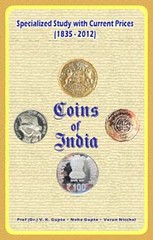 This book will be a delight to numismatics or anyone interested in the collection valuation and study of coins. This catalogue book is a Specialized Study of Coins of India from pre independence era till date with valuations, description representative photos including proof and UNC sets highlighting the individual characteristics and composition of each of these coins.
This book will be a delight to numismatics or anyone interested in the collection valuation and study of coins. This catalogue book is a Specialized Study of Coins of India from pre independence era till date with valuations, description representative photos including proof and UNC sets highlighting the individual characteristics and composition of each of these coins.
Valuation, Variety and Visuals are the three main characteristics of this book. The valuation aims to give collectors an idea of what prices they may have to pay in Indian Rupees. Varieties in coins have been included, from where further research may be carried. Visuals of representative and rare coins have been provided. The book also provides a window into the legal provisions concerning numismatists.
The book has following main chapters, giving detailed description with fine illustrations.: 1. East India Company 2. British Empire Coins 3. Republic Coins 4. Commemorative Coins 5. Proof and UNC Sets.
The technical details of each coin : Year of issue., Rarity, Mintage, Size, valuation ( Fine, V. Fine and UNC ) are given with remarks for each type.
The book contains 344 pages, nearly 4,000 listings with current average market prices (Which is a unique feature), over 770 images, 4 appendices, bibliography and index. The book is highly useful for coin collectors. The printing of the book is very fine so all the illustrations given in the book are of high quality. It is a complete reference book for the lovers of old and new coins. The book is very useful and recommended for all coin collectors .
Authors (s):
Prof. V K Gupta (Author) , Neha Gupta (Author) , Varun Nischal (Author)
Format:
Hardcover
Pub. date:
14.06.2012, 1st ed.
Publisher:
Hobby Book Centre
Language (s):
English
For more information, see: www.bagchee.com/books/BB73046/coins-of-india-specialized-study-with-current-prices-1835-2012
NEW BOOK: DECORATIONS OF SOCIALIST ALBANIA
 The
Decorations
Of
Socialist Albania
An Introductory Guide
The
Decorations
Of
Socialist Albania
An Introductory Guide
By Eric Schena
Albanian orders and medals from the socialist period are very poorly understood and seldom collected, even more than decade since the regime's collapse in 1992. While the awards of many other communist states flooded the market in the mid 1990s (most notably those of the USSR, Bulgaria, and East Germany), Albanian medals continue to remain elusive for most. However, by piecing together what is known, a basic typology and chronology may be assembled to help gain insight into these seldom encountered decorations. The manufacture of Albanian awards has undergone several phases and seems to fall in line with Albania's shifting alliances during Enver Hoxha's regime.
The first decoration established by the partisans was the Medal "Remembrance 1942-1943" which, based on award documents, appears to have been established sometime in 1943. Several months after the partisans successfully wrested control of Albania from Balli Kombëtar, the new communist government established the first series of decorations on July 9, 1945: the Title of "Hero of the People", the Order of the Flag, the Medal of Remembrance (which soon replaced the Medal "Remembrance 1942-1943"), the Order "Partisan Star", and the Order and Medal of Bravery. The first awards established were for service in the anti-Fascist and partisan campaigns of World War II against both the Italians and Germans and carried a great deal of prestige. Soon after, on October 13, 1945, three more orders and two additional medals were added: the Order of Freedom, the Order of Skanderbeg, the Order and Medal of Labor, and the Medal of Liberation.
Interestingly, there are other decorations that were created in the mid to late 1940s that were since replaced with other decorations, in particular the Order "For Labor Merit". Almost nothing is known of this decoration, as it was replaced or outright eliminated sometime before the 1956 regulations were published.
Between the end of 1945 and 1964, several other decorations were established, most notably the titles of Hero of Socialist Labor and Mother Heroine, as well as a series of honorary titles for the arts and sciences.
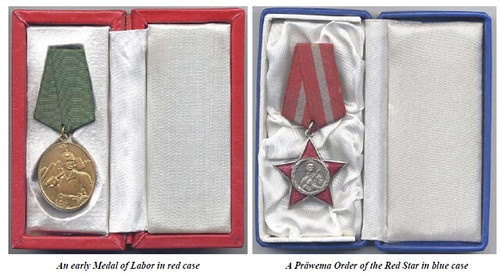
Eric adds:
I wrote this book a few years back on the decorations of communist Albania. It's far from perfect, but it does give a cursory look at what used to be very mysterious medals. I gave this out for free as a two-part web/PDF publication and if folks are interested in getting a copy of a rather esoteric field, they can email me and I'll gladly send it gratis.
MORE ON THE PAPER CURRENCY OF TIBET BOOK
Last week Bruce Perdue forwarded information about a new book on the paper currency of Tibet. Joe Boling writes:
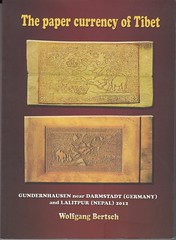 I queried the publisher about the contents of Wolfgang Bertsch's new book on Tibetan paper money, specifically:
"Does this book cover the overprints of Central Bank of China notes with Tibetan inscriptions? These are P216e, 217d, 218f, 219c, and 220c in the Standard Catalog of World Paper Money, volume 2.
"Does the book describe forgeries of the Tibetan laminated-paper wood-block notes?"
The response was: "Everything is mentioned in the book you asked."
The price is $35, which can be remitted through PayPal.
I queried the publisher about the contents of Wolfgang Bertsch's new book on Tibetan paper money, specifically:
"Does this book cover the overprints of Central Bank of China notes with Tibetan inscriptions? These are P216e, 217d, 218f, 219c, and 220c in the Standard Catalog of World Paper Money, volume 2.
"Does the book describe forgeries of the Tibetan laminated-paper wood-block notes?"
The response was: "Everything is mentioned in the book you asked."
The price is $35, which can be remitted through PayPal.
To read the earlier E-Sylum article, see: NEW BOOK: THE PAPER CURRENCY OF TIBET (www.coinbooks.org/esylum_v15n25a06.html)
NEW BOOK: ATTILIO STAZIO: SCRITTI DI NUMISMATICA
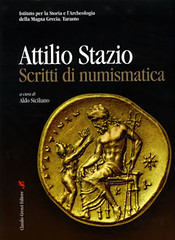 Aldo Siciliano (ed.), Attilio Stazio. Scritti di numismatica. Claudio Grenzi Editore. Foggia 2011. 496 pp. 24 x 31 cm. 32 colour images, 63 black and white. ISBN: 978-88-8431-451-2. 80 euros.
Aldo Siciliano (ed.), Attilio Stazio. Scritti di numismatica. Claudio Grenzi Editore. Foggia 2011. 496 pp. 24 x 31 cm. 32 colour images, 63 black and white. ISBN: 978-88-8431-451-2. 80 euros.
To remember the important Italian numismatist Attilio Stazio (1923-2010) a volume is to appear which collects some of his most interesting but often quite widespread articles and essays.
Aldo Siciliano, president of the Istituto per la Storia e l'Archeologia della Magna Grecia at Taranto - founded and presided once by Professor Stazio - is the editor of the volume.
The book has been published with Claudio Grenzi Editore and can be ordered directly on the publisher's website.
To order, see: Attilio Stazio Scritti di numismatica (www.claudiogrenzi.it/scheda_libro.asp?id_libro=740)
To read the complete article, see: Collection of essays by Italian numismatist Attilio Stazio (www.coinsweekly.com/en/News/4?&id=1282)

BOOK REVIEW: MONUMENTAL MONEY: PEOPLE AND PLACES ON U.S. PAPER MONEY
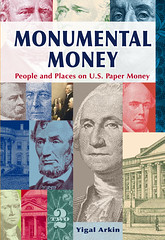 Monumental Money: People and Places on U.S. Paper Money
Monumental Money: People and Places on U.S. Paper Money
by Yigal Arkin
Book Review by Dr. Howard M. Berlin
A very good introductory book about U.S. paper money is the recent release by Yigal Arkin. Titled, Monumental Money: People and Places on U.S. Paper Money, it takes a non-technical look at our country's currency in use from the British Colonial Period to the present day. Unlike U.S. standard paper money books by Hessler or Friedberg, Monumental Money is not intended to be a catalog or guide in the traditional sense. There is no number system or prices given, nor is there a treatise on grading paper money. This is an ideal book for the neophyte or young collector who wants to easily learn the background of our nation's paper money.
Taking advantage of Arkin's own profession in computer graphics and printing and having written previous numismatic books for banks, Monumental Money is liberally illustrated, combining good layout design and use of colors to a maximum advantage to give the reader a visibly pleasing end product.
The book is divided in to three parts. Part 1 presents all the current notes in circulation ($1 to $100), including those designs being slowly withdrawn from circulation as newer designs replace them, including the newest 2011 $100 note. It also includes excellent color images and a brief description of the people on the face, sites on the back depicted on each banknote, and even the facsimile signature of the person on the face of the note. After each denomination there is a "Did You Know?" list of several facts about the person that appears on that note.
Part 2 presents a brief review of the history of the U.S. monetary system through the many types of banknotes in use from the time of the British Colonial Period from approximately 1690 to the present day. There are 13 color-coded categories, each with one or more color illustrations, both face and back, of the notes issued during these periods: Colonial Continental Currency, 1760-1788; Interest-Bearing Notes, 1812-1907; Demand Notes, 1861-1862; Confederate Currency, 1861-1865; Fractional Currency, 1863-1876; United State Notes - Legal Tender, 1862-1994; National Currency, 1863-1938; Gold Certificates, 1865-1936; Silver Certificates, 1878-1965; Treasury Notes - Coin Notes, 1890-1899; Federal Reserve Notes, 1914-present; Federal Reserve Bank Notes; 1915-1945; and Emergency Notes, World War II.
Part 3 presents the high-denomination notes that are no longer in circulation, which most people possibly never knew existed. These denominations, although large by our standards wouldn't come even close to those used by the hyperinflation notes of some post-WWII European countries. These notes are the $500, $1,000, $5,000, $10,000, and $100,000 issues.
Monumental Money is a hardbound, 112-page book with index, approximately 7x10 inches filled with over 200 high-quality color illustration of notes, the people, and places related to the notes. It is reasonably priced at $17.95 (ISBN 978-0-615-46454-1). It is distributed by Small Press United (IPG, www.ipgbok.com) and can be purchased on Amazon.com.
BOOK REVIEW: FRENCH MEDALLIC ART: 1870-1940
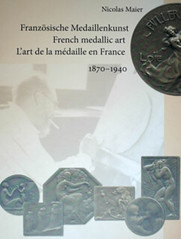 For nearly forty years I had wondered about a vague series of French art medals that had preceded the Circle of Friends of the Medallion series (1909-15) in America. I had read brief notices in early 20th century issues of The Numismatist when a new medal in the French series was issued. But in my mind I could not put the entire series into focus.
For nearly forty years I had wondered about a vague series of French art medals that had preceded the Circle of Friends of the Medallion series (1909-15) in America. I had read brief notices in early 20th century issues of The Numismatist when a new medal in the French series was issued. But in my mind I could not put the entire series into focus.
For the decade I was a medal dealer, in the 1970s and 80s, I even sold some of the medals in that series unaware they were part of a magnificent group that showcased the best medallic art of the French practitioners of this glyptic art. My shortcoming.
 Now we have a German numismatic scholar, Nicolas Maier, who has brought that French art medal series into focus. He has documented every issue of this series, the events that led up to its creation, revealed the details of its birth, and the casualness of the issues in its declining years. Not only does he illustrate every art medal in the series, he illustrates every one of their creators as well.
Now we have a German numismatic scholar, Nicolas Maier, who has brought that French art medal series into focus. He has documented every issue of this series, the events that led up to its creation, revealed the details of its birth, and the casualness of the issues in its declining years. Not only does he illustrate every art medal in the series, he illustrates every one of their creators as well.
Also -- to give perhaps a sense of the beaux arts climate in which these medals were issued -- he discusses 73 French medallists and their medallic creations to provide the influence this series had on other medalists of the period.
The Societe des Amis de la Medaille francaise (the Society of French Medallic Art) which the author refers to as SAMF throughout the book, was formed by art critic Roger Marx the last year of the 19th century, 1899. In a touch of French irony this is the same year that Victor Janvier was granted the patent for his reducing machine, his pantograph that was to have such an influence on the French development of this art.
For now -- after centuries of tedious hand engraving dies in exact size -- an artist could model in clay, or wax, to create an oversize pattern of his intended medal. Knowing full well, his images would be reduced with great fidelity on Janvier's magic-like pantograph to cut a die that could stamp his intended images in permanent bronze or other metal in the required size for any number of desired specimens. This was a far superior method of medal making than the casting of large medals one at a time by foundry casing methods previously employed for such medallic items.
The plan of SAMF was to issue five new medals a year, this was accomplished for the first decade, from 1899 to 1909 (save the first year and 1908 when only four each were issued). With this requirement there was no attempt to have each new medal by a different artist. It appears whoever came up with a suitable model, theme and satisfactory execution got the commission from Marx.
Design, content, style, lettering was all the choice of the artist for each of the 63 medals in the series. Let the artist be inspired, let his creative juices flow. This is great medallic art. Themes of nature, children, animals abound in the series. Universal appeal to any viewer!
The author credits David d'Anders (1788-1856) for his portrait reliefs, beginning in 1825, as a forerunner of French medallic art. Likewise he names Herbert Ponsdcarme (1827-1903), considered the Father of the Modern Art Medal with his 1863 medal for the Academy of Inspiration for Beaux-Letters bearing the portrait of Joseph Nadet. These artists inspired Roger Marx to create a series to promote French medallic art.
His idea was copied by a similar series in the Netherlands, and, in America (with the 12-medal Circle of Friends). Perhaps it could be considered the concept for the later American series of the Society of Medalists as well (with only two medals a year, each named for their issue number, and each intended to be by a different American artists).. All these series gave the artist free reign in designing and modeling a theme of his choice. This in contrast to a commercial commission to honor an anniversary or some celebratory event with a design thrust upon the artist.
The illustrations alone are worth the cost of the book, with 73 single-sided medals and 275 two-sided medals pictured. Plus images from the Paris Mint at the turn of the century where most of these medals were struck on the equipment illustrated. That giant balancier (screw press) page 26 could strike medals in large size.
Don't overlook the chart, page 62-63, which lists all SAMF medals. Wished I had had that list forty years ago. The text is in English, French and German. Recommended.
SUPPORT THE AMERICAN NUMISMATIC SOCIETY LIBRARY
I'm developing a new ANS Library support webpage. This essentially outlines the many different ways that interested people can be part of helping the ANS Library grow and thrive. That page is here: numismatics.org/Library/Support
Of particular interest to E-Sylum readers might be the section of duplicate books for sale, at the bottom of that page. The direct link is: numismatics.org/Library/LibraryDuplicates
All proceeds benefit the ANS Library. I will be updating this list at the start of each month as best I can (there is just so much to do lately, especially since I am currently without an assistant / cataloger, so I imagine the new listings will only be a handful here and there, but it's a start.
- Cataloger Funding
- Rare Book Cataloger Funding
- Book Preservation (Adopt-a-Book)
- Shelf naming
- Book donations
- Volunteering or interning
NUMISMATIC NEWS HITS 60TH ANNIVERSARY MILESTONE
As I set myself to recording the thoughts and reflections which follow to electronic storage, embracing that three generations of time, it is early March, the commencement of my 50th year of association with the publication.
While I had not been a recipient of that introductory issue, I had become a subscriber somewhere down the road in the mid-'50s, I don't recall just when, but it was probably in 1955 or 1956. At the time I'd been a collector for five years or so, since the late summer of 1950, and had already subscribed to the Numismatic Scrapbook Magazine and The Numismatist.
Reflecting back, a few words that Chet shared with his first edition audience fit me perfectly; "Far away from the coin clubs, far away from coin shops, live thousands of collectors who rarely see another person whose interests are in harmony with his. His collecting is known to only a few and these are not especially interested except that he has so much money."
That was me in a nutshell. With the school year of 1954 winding to a close, as a freshman I joined my fellow schoolmates in the exercise of presenting that year's yearbook to friends and acquaintances for the penning of brief autographed thoughts. I recall a neighborhood schoolmate, one of the graduating seniors, offering up the wish; "May you collect all of Midas' coins." I was certainly not that fortunate, of course, but I have had the enjoyable opportunity of collecting a few.
To read the complete article, see: Numismatic News hits 60th Anniversary Milestone (www.numismaster.com/ta/numis/Article.jsp?ad=article&ArticleId=25359)
"THE CALIFORNIA NUMISMATIST" AVAILABLE FREE ONLINE
Greg Burns, Editor of "The California Numismatist" writes:
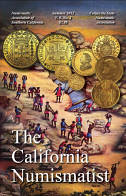 As I read the blurb in the most recent release of "The E-Sylum" regarding Moneta (publication of the Ottawa Numismatic Society - ONS) I thought I'd also mention that the governing boards of both the California State Numismatic Association (CSNA) and the Numismatic Association of Southern California (NASC) recently decided to again offer their joint-journal, The California Numismatist (TCN), to the Internet community for free as well.
As I read the blurb in the most recent release of "The E-Sylum" regarding Moneta (publication of the Ottawa Numismatic Society - ONS) I thought I'd also mention that the governing boards of both the California State Numismatic Association (CSNA) and the Numismatic Association of Southern California (NASC) recently decided to again offer their joint-journal, The California Numismatist (TCN), to the Internet community for free as well.
TCN has won the ANA's first-place "Outstanding Regional Numismatic Publication" award since the magazine's inception in 2004 (seven straight years so far). All issues are available on-line for free download (www.CalNumismatist.com) with the exception of whichever is then most-recent (that being limited to the first few pages, including the table of contents - you know, to whet the appetite). As the ONS expressed in the blurb, both the CSNA and NASC wish to make the very best of numismatic publications available to as many inquisitive minds in the public at large as possible, and in so doing hope to promote the overall health of the hobby.
Regards,
Greg Burns
Editor, "The California Numismatist"
www.CalNumismatist.com
ON THE FIRST EDITION OF RAYMOND'S STANDARD CATALOGUE OF U.S. COINS
David Fanning writes:
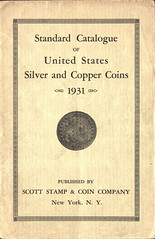 Concerning Raymond's Standard Catalogue of United States Coins, the "conventional wisdom" mentioned by David Lange remains correct: the first edition was published in hardcover in 1934. What he has is an earlier publication covering only silver and copper coins. Raymond published a number of earlier works of this sort, covering only selections of the U.S. numismatic spectrum. It is not at all rare; when it is offered, it would usually be in a bulk lot.
Concerning Raymond's Standard Catalogue of United States Coins, the "conventional wisdom" mentioned by David Lange remains correct: the first edition was published in hardcover in 1934. What he has is an earlier publication covering only silver and copper coins. Raymond published a number of earlier works of this sort, covering only selections of the U.S. numismatic spectrum. It is not at all rare; when it is offered, it would usually be in a bulk lot.
To read the earlier E-Sylum article, see: QUERY: EARLY EDITION OF RAYMOND'S STANDARD CATALOGUE OF U.S. COINS (www.coinbooks.org/esylum_v15n25a11.html)
A RELIC MEDAL OF THE GERMAN SUBMARINE DEUTSCHLAND
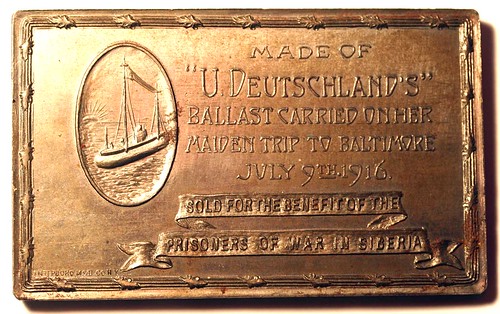
The Deutschland was the first German submarine to cross the Atlantic Ocean. The 790 ton cargo vessel was approximately 230 feet in length, and carried a crew of four officers and twenty-five men. On the surface, her speed was fourteen or fifteen knots; when submerged, it was about half that. Paul Konig, her commanding officer, had not served in the German navy; he was a captain of the North German Lloyd Line, builders of the Deutschland, but because of German law that made him a member of the naval reserve.
Konig sailed his vessel for Baltimore on June 18, 1916, carrying a cargo consisting of some "750 tons of medicinal and coal-tar dye products." He successfully eluded the British ships which were patrolling off the coast of Virginia, navigated up the Chesapeake Bay, and entered Baltimore harbor on July 9th. The submarine docked at Locust Point, a peninsula on the west side of the Inner Harbor.
At this time, Great Britain was at war with Germany, but the United States had not yet entered the conflict. The purpose of the German submarine's visit to America was to sell her cargo, which had a value of 1.5 million dollars. And, even more importantly, they wanted to purchase strategic war materials such as nickel, rubber, and tin. The Germans were successful on both counts; they sold their merchandise and on August 2nd left Baltimore with a full cargo, much of which was stored outside the submarine's pressurized hull.
On October 2nd the Deutschland left Bremen and made her second trip to America. This time her destination was New London, Connecticut, and she arrived there on November 1st. She returned to Germany on November 17th, carrying nearly a thousand tons of nickel, tin, and crude rubber, with an estimated value of two million dollars.
There would be no more such trips for the Deutschland. On April 6, 1917, the United States declared war on Germany. The submarine was converted from a cargo vessel for war duty, and was given the designation U-155. During the span of three cruises she sank more than forty ships.
Two interesting numismatic items commemorate the submarine's visit to Baltimore. The best known of these is a heavy iron medal in the shape of a cross. It is about 13mm thick and 73mm across. On each side, the date, 9 JULI is at the top, and the year 1916 at the bottom. Inset in the center of each side is a brass medal approximately 29mm in diameter. One of these features Kuhn's bust, with U-DEUTSCHLAND above and PAUL KONIG KAPITAN below.
On the other side, the submarine is depicted in the center. The Dove of Peace is in a small oval at the top, with IN BALTIMORE 9 JULI 1916 in two lines on a banner just below it. Around, the inscription is ZUR ERINNERUNG AN DIE ANKUNFT DES ERSTEN HANDELS U-BOOTES, which I believe translates roughly to "in commemoration of the arrival of the first commercial U-boat." One of these medals was sold at a major numismatic auction a couple of years ago and the cataloguer commented that "these were presented to business leaders in the U.S. that the U-boat company wanted to curry favor with for future dealings."
The second medal seems to be quite a bit scarcer than the one just described, and not as well known to collectors. It is a 50x82mm rectangular piece, struck in iron on a uniface planchet. The submarine is depicted to the left, within an oval. The seven-line inscription is MADE OF / "U. DEUTSCHLAND'S" / BALLAST CARRIED ON HER / MAIDEN TRIP TO BALTIMORE / JULY 9TH 1916. / SOLD FOR THE BENEFIT OF THE / PRISONERS OF WAR IN SIBERIA (the last two lines are on ribbons). The medal was struck by the Interboro Medal and Badge Manufacturing Co. of New York City, and it is signed at the bottom, in tiny letters, INTERBORO M. & B. CO. NY.
These medals are interesting from an historical standpoint. And, from a numismatic standpoint they are popular, as are all "made from" relic medals.
THE BOOK BAZARRE
"HONEY, I HID THE COIN COLLECTION!"
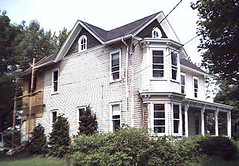 I had a dream last week. But not the Martin Luther King, Jr. kind, or the "Hey, I can fly!" kind. I was travelling out in the countryside, going past farms and some dilapidated old houses. I came to a big old wooden house and walked up on the porch and in the front door. I was in a central hallway, and could look into other rooms on the first floor and see doorways on the second floor. I was waiting for more people to arrive. My daughter was there, walking around and playing on the stairs and second floor. Other family members arrived. Then I remembered why I was there - we were a search team, and our job would be to go through the house with a fine-toothed comb, looking for hidden valuables.
I had a dream last week. But not the Martin Luther King, Jr. kind, or the "Hey, I can fly!" kind. I was travelling out in the countryside, going past farms and some dilapidated old houses. I came to a big old wooden house and walked up on the porch and in the front door. I was in a central hallway, and could look into other rooms on the first floor and see doorways on the second floor. I was waiting for more people to arrive. My daughter was there, walking around and playing on the stairs and second floor. Other family members arrived. Then I remembered why I was there - we were a search team, and our job would be to go through the house with a fine-toothed comb, looking for hidden valuables.
We knew something was there, but didn't know what or where it was hidden. When the last of us arrived, we would start. I anticipated going through drawers and dusty closets, sorting through papers and junk. Would I find a rare autograph? A valuable First Edition? Coins? Or would the treasure be an old lamp or piece of jewelry? I fantasized that I would be the hero and recognize whatever it was after the whole crew had passed it by without notice. But I also feared that I'd be the clueless one, not recognizing the true treasure if it were handed to me on a velvet pillow by glowing angels.
I woke up before the search ever began, so I guess I'll never know how the story ended. But that day when I came home from work some mail was waiting for me on my desk. Near the bottom of the stack was my copy of the May 2012 issue of the John Reich Journal, a publication of the John Reich Collectors Society. I was drawn to an article by John McCloskey titled "The David J. Davis Bust Dime Collection".
Dave was a longtime E-Sylum subscriber who'd passed away recently. I had met him several times at various coin shows and NBS events. He was always doing some numismatic research, or assisting others with theirs. It's a great article that describes how Davis, McCloskey and others came to write the definitive reference on U.S. Bust Dimes. Here are two excerpts from the article, which JR Journal Editor Brad Karoleff kindly forwarded at my request. The second part stopped me in my tracks when I saw it. Read on to learn the connection to my dream.
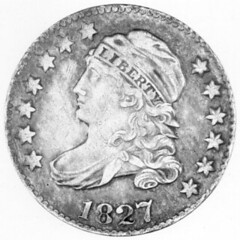 David Davis began collecting Bust dimes in the 1960s before there was any published die variety reference material on this series in the numismatic literature. He was however familiar with the books describing die marriages for Bust half dimes by D.W. Valentine, Bust quarters by Ard W. Browning and Bust half dollars by Al C. Overton. These standard reference books on Bust coinage gave this budding numismatic scholar a wealth of valuable information on Bust coinage that would help him organize his research on the Bust dime series in future years.
David Davis began collecting Bust dimes in the 1960s before there was any published die variety reference material on this series in the numismatic literature. He was however familiar with the books describing die marriages for Bust half dimes by D.W. Valentine, Bust quarters by Ard W. Browning and Bust half dollars by Al C. Overton. These standard reference books on Bust coinage gave this budding numismatic scholar a wealth of valuable information on Bust coinage that would help him organize his research on the Bust dime series in future years.
I began collecting Bust dimes in 1969 and initially planned to obtain a date set from 1809 to 1837. However, when I upgraded the pieces in my collection I quickly noticed differences in date styles for coins with the same date, differences in the placement of the lettering and stars around the periphery of the obverse and reverse designs as well as die scratches, die cracks and cuds that appeared on only a fraction of the coins of a given date. I began to prepare written descriptions for the pieces I owned to see if they matched the features of new pieces I encountered at shows. When I found a piece that didn't match the description for any of the pieces that I owned, I bought it.
I realized I needed help identifying the die marriages for Bust dimes and sought out other collectors with experience in this field. I remember reading an article in Coin World by Walter Breen in the early 1970s describing the different date styles on 1835 Bust dimes. I wrote a letter to Breen asking him if he could provide me with the names of other collectors with whom I could work in identifying die marriages of Bust dimes. It wasn't long before I received his reply with an address for David Davis indicating that this individual was a serious numismatic scholar with extensive knowledge of Bust coinage.
I quickly contacted David Davis and it wasn't long before we were meeting at local coin shows and exchanging information on the coins that we had purchased in the Bust dime series. Within a few months we met Russ Logan at a local show in Ohio and the three of us started comparing notes on the coins in our die marriage collections.
This work led to the foundation that resulted in the die marriage descriptions for the dime book that was published in 1984. Over a period of twelve years the three of us identified 122 die marriages for the Capped Bust dime series from 1809 to 1837. David Davis completed this die variety set and retained his collection until his death on November 2, 2011.
In his will, David asked me to facilitate the sale of [his] important collection for his estate. In December 2011 David's widow Janet Davis withdrew the collection from the bank vault in Michigan and gave it to me to document for sale at auction. Upon receipt of the coins I prepared a listing that included 136 pieces from the collection.
I discovered that there were many duplicates in the set but surprisingly, many of the rare dates were missing. There were no 1809, 1811, 1814, 1822, 1823, 1824 or 1825 dimes and some of the die marriages were missing for the 1820, 1821, 1827 and 1829 dates. This was a disaster because we didn't have a complete collection and many of the important pieces were missing. I contacted Janet with this news and she was unable to explain what happened to the lost pieces. After discussing this issue with a number of people who knew David, we finally obtained an explanation for the missing coins.
David had been seriously ill for over two years before his death and at various times he underwent some very demanding sessions in the treatment for his illness. However, he was well enough to attend the ANA Convention in Boston during August 2010. It seems that he had taken some of the coins in his collection from the vault before the ANA Convention and forgot to return them before leaving for Boston. Not wanting them to be stolen in his absence, he hid them in what he considered to be a very safe place around the house. After undergoing subsequent treatments for his illness, he confided to one of his coin friends that he couldn't remember where he had hidden the missing dimes. After his death nobody knew where to look for the lost pieces.
Janet Davis now had a very serious problem; she simply didn't know where to look for the missing dimes. After a number of searches produced no coins, she decided to invite several family members over for a complete search of the Davis home in a final effort to resolve the problem. This time the coins were found in a well hidden place that no burglar would have been able to find. Fortunately however, the family was eventually able to locate the lost pieces to present the entire collection for sale. The secret hiding place produced 63 more Bust dimes including examples of the rare dates that had been missing.
For more information about the John Reich Collectors Society, see: www.jrcs.org
BENEFACTOR PURCHASES AND LENDS HISPANIC COINS TO THE ANS
When the financially struggling Hispanic Society of America decided to sell its collection of nearly 38,000 rare coins last year, that Upper Manhattan museum sought to allay fears that its cultural treasure would become inaccessible to scholars and the public by striving to find a public institution to buy it. None, however, was found to purchase the collection, valued at more than $25 million; the coins landed in private hands; and some of those scholars' concerns are now being realized.
About 1,000 of the coins will be auctioned in Madrid next week, likely to scatter them even more. But an unidentified American coin buff who bought 10,000 pieces from the collection recently arranged a long-term loan with the American Numismatic Society, making them publicly available, said Ute Wartenberg Kagan, the executive director of the Numismatic Society, whose headquarters are at Hudson Square in the South Village.
Though Ms. Wartenberg Kagan said she was saddened by the dismantling of the collection, the loan softens the blow.
"The Hispanic Society got the money, and we got 10,000 of the really good coins," she said. "It's good for New York, having this material back, because who knows where it will end up. This type of collection disappears and is never seen again."
Nine thousand of the coins arrived at the Numismatic Society late last week, joining 1,000 that had arrived earlier. Ms. Wartenberg Kagan said the batch included more than 1,000 coins of the Visigoths ("arguably the most important Visigothic collection in the world," she said); other early-medieval coins; more than 3,000 bronze and silver Roman coins; and about 4,000 Spanish coins of medieval and later periods.
"The greatest concern about any dispersal of the collection focused largely on the coins now back at the Numismatic Society," Mitchell A. Codding, the Hispanic Society's executive director, said. "They have been heavily researched, and there is constant utilization by scholars. It's good they'll be available to scholars."
Despite the current easing of tension between the Numismatic Society and the Hispanic Society, scholars are concerned that the collection has been split. Alan Stahl, the curator of numismatics at Princeton University, said he hoped that at least the coins lent to the Numismatic Society would eventually be donated outright.
"I want it all," Mr. Stahl said, "with all the information possible, with the history of each piece to be available for study, for exhibition, for illustrations."
To read the complete article, see:
Coin Collection Is Partly Saved by a Loan
(www.nytimes.com/2012/06/20/arts/some-coins-sold-by-hispanic-society
-go-to-numismatic-society.html?_r=1)
See also:
Counting the Money: More Details on Hispanic Coin Trove Returned to the American Numismatic Society
(www.artsjournal.com/culturegrrl/2012/06/counting_the_money_more_detail.html)
Coins resale expected to bring millions
(www.newstimes.com/local/article/Coins-resale-expected-to-bring-millions-3657996.php)
DICK JOHNSON OFFERS NEW BOOKS ON MEDAL TOPICS
 Monograms of American
Coin and Medal Artists
By D. Wayne Johnson
Monograms of American
Coin and Medal Artists
By D. Wayne Johnson
My own compilation of all those initials and monograms found on obscure numismatic items to aid identifying item & original artist. 545 initials of 300 artists!
Paperbound.. Postpaid. $44.
 New! French Medallic Art:
1870-1940 / Nicolas Maier
New! French Medallic Art:
1870-1940 / Nicolas Maier
Monumental research on French medallic works-the artists and the items, plus full details on the first art medal series, never told before! Precedes Am. Society of Medallists. Plus biographies of sixty French artists and their medallic works. In English, French, and German.
Hardbound. Postpaid. . $155.
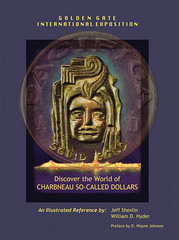 Charbneau So-Called Dollars
By Jeff Shevlin & Bill Hyder
Charbneau So-Called Dollars
By Jeff Shevlin & Bill Hyder
Fascinating story of Jules Charbneau, his gold Dollars (HK 487-490) issued at San Francisco Expo, varieties of the charming gold pieces, his collecting of miniature items; plus attempt to identify unknown CMJ who engraved the dies. Full page color plates of all 13 varieties and illustrations of associated items.
Hardbound. Postpaid.. . . . . . . $33.
 Medal-Of-The-Month Club By
Felicity Buranelli. Compiled &
illustrated by Harry Waterson
Medal-Of-The-Month Club By
Felicity Buranelli. Compiled &
illustrated by Harry Waterson
Enigmatic series of aviation medals so charmed the author he researched and wrote a scholarly book on the dozen medals in a planned medal series halted by World War II. Full history medals, lady who had idea of a monthly series. Just published!
Paperbound.. Postpaid. . . $30.
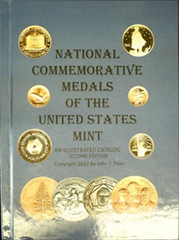 U.S. National Commemorative
Medals. 2nd ed / John Dean
U.S. National Commemorative
Medals. 2nd ed / John Dean
Just published in a revised and updated version. Complete list, descriptions, and illustrations of U.S. Mint Medals made since 1940. With Dean catalog numbers. Order book and get FREE Price Guide / Checklist. Carry this to coin shows.
Hardbound. Postpaid. . . . . . . . .$48.
 U.S. National Commemorative
Medals. / By William Swoger
U.S. National Commemorative
Medals. / By William Swoger
Must Have Book if you collect these U.S. Mint medals. Author found nuggets of information on these American medals found nowhere else, based on extensive research. Colorful illustrations of medals plus related associated collectable items.
Hardbound. Postpaid. . . . . . . $225.
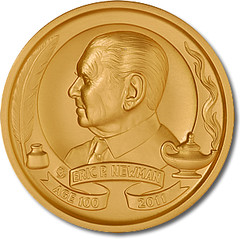
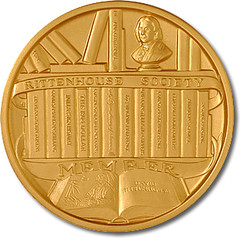
ERIC NEWMAN CENTENNIAL MEDAL Issued by Rittenhouse Society for Famed Numismatist's 100th Birthday, May 25, 2011 As medal chairman I had the pleasure of guiding this medal through creation, production and bestowing it to Eric Newman in person on his centennial birthday. Bronze, Postpaid $50. Silver. Postpaid $245.
(PayPal and credit card orders forwarded to my firm,
Signature Art Medals, & orders shipped from Massachusetts.)
Dick Johnson
139 Thompson Drive, Torrington, CT 06789
dick.johnson@snet.net
Dick adds:
I prepared this as an ad for my firm, Signature Art Medals. As I promised a group of my author-friends -- including Harry Waterson, Jeff Shevlin, Bill Hyder, John Dean and Bill Swoger -- I would help sell their medal books.
I will be glad to be shipping clerk for two weeks only. That should fulfill my promised obligation. If, however, you read this after July 4, 2012, or want to pay by credit card or PayPal send your order to Signature Art Medals, Box 920, Groton, MA 01460 or signatureartmedals@charter.net
MORE ON MICHAEL ANNIS
Regarding dealer Michael Annis who is hospitalized with Lou Gehrig's disease, Beth Deisher writes:
I was in communication with Mike via iPad last weekend. One suggestion is for friends to include iTunes gift cards in their letters and cards. He could use the gift cards to purchase and download music and material (books and magazines ) to read on his iPad.
Beth Deisher writes:
My husband, Art, and I just returned from Michigan, where this afternoon we spent two hours with Mike Annis.
Due to the effects of ALS Mike can no longer speak. He can still hold a pencil and prints responses and questions on notebook pads when not using an iPad. He uses a walker to get around. His movement is slow, but he appeared surprisingly strong. He has great difficulty swallowing and can take only limited amounts of liquids. Consequently, he is very thin.
Mike's mind is keen and he seemed very happy to have received cards and email messages from dealers and friends in the numismatic community in recent days. He has not lost his sense of humor and still has a positive attitude.
He is the only ALS patient in the facility and it is clear that he would be better served in perhaps another type of environment. A decision will be made this week regarding relocating to another facility.
Please take a moment this week to send him an email or card. Knowing someone is thinking of him means a great deal to Mike.
To read the earlier E-Sylum article, see: NOTES FROM E-SYLUM READERS: JUNE 3, 2012: Michael Annis Contact Information (www.coinbooks.org/esylum_v15n25a08.html)
NOTES FROM E-SYLUM READERS: JUNE 24, 2012
Corrections to the June 17, 2012 Issue
Last week I excepted an article and noted "Rumors in India that a certain coin contains gold have led hoards of people to buy them up." Kavan Ratnatunga and Allan Speedy chimed in on the correct location of the story.
Allan writes:
The Swat valley is in fact one of the North-South orientated valleys of Northern Pakistan, NOT India.
My wife and I were in Swat during our honeymoon in the year 2000. Here are some scenic photos: www.speedy.co.nz/pakistan/swat.htm
Kavan writes:
It reminds me of a story from Lanka. A few years ago someone placed an advert in a local newspaper that they will pay Rs700,000/- for a Rs 1 currency note of 1940 with QEII, non-existent note. I later saw an image of a 1952 note which had been clearly Photo-shopped. It generated an uncanny interest among those who knew nothing about currency notes, and spiked the price of all Rs1 currency notes of that era by 10 times, which was probably the intent of the scammer who probably had an excess notes to sell.
I took it up with the editor of the Newspaper and told him that his newspaper was used to execute a scam. He explained that it was impossible for them to detect and prevent such adverts.
To read the earlier E-Sylum article, see: RUMORS DRIVE CROWDS TO PURCHASE ONE-RUPEE COINS (www.coinbooks.org/esylum_v15n25a17.html)
In Dick Johnson's item on the memorial service for Bert Bressett, he wrote "Internment was to be in back in Keene, with a memorial service later in June." Joe Boling writes:
That's interment, not internment.
In the "There you go again" department, Gene BrandenBURG writes:
Wayne, I'm giving you free-of-charge - a tattoo for the inside of your eyelid which reads "BRANDENBURG, NOT BRANDENBERG". It's the same spelling as the gate and/or the concerto. Bach managed to get it right and with practice, you can too ! Any tattoo parlor and eyelid of your choice !
To read the earlier E-Sylum article, see: WAYNE'S NUMISMATIC DIARY: JUNE 17, 2012 (www.coinbooks.org/esylum_v15n25a13.html)
Joe Boling writes:
Howard Daniel hasn't been to Europe lately (as a Numismatourist). You got it right two lines later.
To read the earlier E-Sylum article, see: THE NUMISMATOURIST'S LATEST TRAVELS IN EUROPE (www.coinbooks.org/esylum_v15n25a14.html)
On the Smell of Money
Elizabeth Hahn writes:
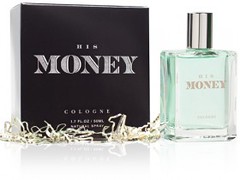 Your posting in the latest E-Sylum about the smell of money made me remember an entertaining article I saw recently about a company that creates perfumes with this exact smell! There is even a website that directly sells the scent:
www.liquidmoney.com/?page_id=119
Your posting in the latest E-Sylum about the smell of money made me remember an entertaining article I saw recently about a company that creates perfumes with this exact smell! There is even a website that directly sells the scent:
www.liquidmoney.com/?page_id=119
The full article is here (Money is slide / photo 9) in this link: shine.yahoo.com/photos/real-scent-perfume-book-scents-slideshow/
Here's the product blurb for the Men's version. What woman could resist your charms!
-Editor
Packed in real shredded US dollar bills, His Money is a woody-fresh fragrance paired with the unique aroma of newly-printed bills. Powerful and fresh aquatic notes are crowned with hints of green grass, intense rosemary, and a twist of citrus underscored by aromatic blonde woods. Mist onto skin and revel in the bliss of success. Masculine and daring.
To read the earlier E-Sylum article, see:
THE SMELL OF MONEY
(www.coinbooks.org/esylum_v15n25a12.html)
Kudos from Readers
Dave Bowers writes:
Nice to have you back!
Greg Burns,
Editor of "The California Numismatist" writes:
I browse each issue of "The E-Sylum", whether or not each specific item within it "speaks to me". As an editor/publisher myself I find it hard to believe you're able to churn this little gem out every week. Fifteen volumes is quite an impressive accomplishment. It's a great benefit to all who read it. You must have the stamina of a twenty-something. Congratulations.
International Bank Note Society Book Judges Sought
I recently attended the International Paper Money Show in Memphis and was present for a couple of the International Bank Note Society (IBNS) board meetings as a Director and head of the YN Committee. One item that came up was the need for replacements for the two judges of new paper money books and IBNS Journal articles. One of the judges has been doing the job for over 25 years and would like some relief. I immediately thought about our NBS members and that some of them are likely IBNS members too. And with our love for books and articles and writing them, NBS/IBNS members would be great judges. If any NBS/IBNS member is interested, please contact me at HADANIEL3@MSN.COM. If someone is interested and not an IBNS member, please contact me too.
Howard A. Daniel III writes:
QUERY: NAMED WOODWARD OCTOBER 1864 SALE SOUGHT
George Polizio writes:
I'd like to ask our readers for a little help. I was hoping someone has a named auction catalogue from W. Woodward from October 1864, and if they do can they tell me who the buyer(s) were for lots 2336, 2337, 2338, and 2428.
I am researching a token that was struck to the order of J. Osborn Emery by George Lovett using dies that Lovett had used earlier to strike tokens for Augustus Sage. I just purchased a token from John Kraljevich that is a muling of Washington's Headquarters at Valley Forge with Washington's Headquarters at Tappan. The token is copper and has a reeded edge. In the Woodward cat. he lists pieces in copper, brass, tin and silver. Woodward is vague as to how many were struck for Emery, but the token is pretty neat!
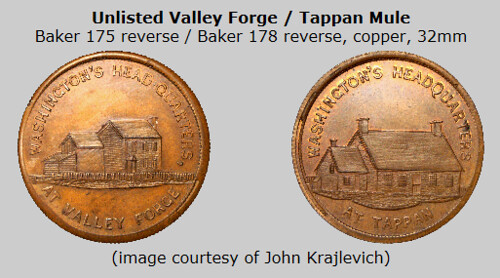
We have the following coin books and these are the absolutely LAST QP books regarding coins that exist. (We have 12,000 lbs of stamps books to work on now) All are new and have plastic heat seal wrapping on them, and we are selling them as a lot only. They are-
The Coinage of Latin America and the Caribbean - 11 copies
Medallic illustrations of History Great Britain & Ireland - 1 copy
Brunk/World Countermarked Coins - 44 copies
Stewart/History First US Mint - 3 copies
Adams/Plates Hard Time Tokens - 34 copies
Storer/Numismatics of Massachusetts - 4 copies
Wright/ American Business Tokens - 2 copies
THESE ARE TO BE SOLD AS A TOTAL LOT AND ARE NOT AVAILABLE FOR INDIVIDUAL SALES !
I'm looking for $1,500 for these all together or your absolute best offer that is close. The first individual to contact me at or close to the asking price has them. Please email me, Dave Hoch, the executor of my Dad's Will, Alfred Hoch at dave@davehoch.com If you are interested. Thank you in advance. -Dave
ALAN WEINBERG ON ORGANIZED COIN DEALER THEFTS
After reading the brief account of Julian Leidman's organized crime theft of coins once he left the Connecticut show ( two years back now? ) and the reference to increasing thefts at coin shows by organized "follow-home" criminal groups, an important factor was overlooked.
The crime does not start once the dealer packs up and leaves the coin show. It literally starts while the coin show is still in progress. Does anyone really believe that the criminals target just any dealer with bags leaving a show? They could just as easily choose a dealer specializing in raw 2x 2 Jefferson nickels and Lincoln cents or inexpensive exonumia. That is simply not the case. They want bullion and / or expensive slabbed coins.
I distinctly recall Julian's retrospective recount of what he observed while still set up at the Connecticut coin show.
First, as I remember reading (perhaps on the PCGS Coin Forum), Julian wrote that he recalled a woman repeatedly checking out at a distance his display bourse cases while wandering back and forth in the show aisles but never seemingly buying any coins at other tables. Julian's coins often bear large prices plainly visible from several feet away - I distinctly recall a prooflike Unc. 1806 half dollar boldly labeled $125,000 in his bourse case.
And Julian also wrote that as he was leaving the show bourse floor, all packed up and heading to his vehicle, he spotted a woman (the same woman?) near the bourse room exit on a cell phone and overheard her saying into the cell phone "He's leaving now" . All this was in retrospect and did not mentally register with Julian as it happened. Understandable, as any dealer is tired after a show and eager to get home. [ How's this going to play out in Philadelphia when dealers will be behind their tables or at auctions from July 26 - August 11? Two weeks! ]
I've little doubt - having read over and over of similar show "follow home" thefts and with my retired LAPD background and countless show attendances over the decades - that these criminal groups are more sophisticated and carefully planned/organized , even with backup "follow home" cars and cell phones and phony ID's if they're caught, than in past decades when they would arbitrarily pick off a dealer for what was reported back then as a $200 per bag award for any theft.
These massive financial crimes of, say, $500,000 worth of numismatic items at a time , are still regarded by law enforcement in any state, as a "property crime" - even often suspected as insurance fraud - no more serious than a $1,000 theft and the criminal , if and when caught, is booked with a trivial bail like $1,500. They supply a false ID, the gang bails them out for $1,500 cash and they flee the jurisdiction well before their fingerprints are matched with interstate and FBI comparison. The same criminals under multiple false names and dates of birth are often "good for" dozens of similar expensive and financially devastating crimes across many states. The "goods" almost immediately change hands and are often fenced off within a matter of days, almost as an airport or bus terminal pickpocket "hands off" his loot.
It is almost impossible to put together a successful criminal case much less get a substantial sentence for a captured thief. Talk to early copper dealer Tom Reynolds whose "follow home" convicted Russian organized crime thieves got less than 2 years with not all the coins recovered.
That's what we're looking at. The crime starts in the coin show bourse room - and that's where security and bourse dealers should first be aware of cell phone use by unfamiliar persons - sometimes women - roaming the aisles or persons seemingly devoid of numismatic knowledge. Such persons should be challenged by show security and escorted out of the show and out of the parking lot if they cannot present a reasonable explanation for their presence. Every show should have a policy clearly stating that anyone can be denied entry or escorted off the premises. Virtually any store has such a posted policy. Why not coin shows?
To read the earlier E-Sylum article, see: WASHINGTON POST ARTICLE ON THIEVES TARGETING COIN DEALERS (www.coinbooks.org/esylum_v15n25a10.html)
STOLEN DOCUMENTS AND MEDALS RETURNED TO CHICAGO'S POLISH MUSEUM
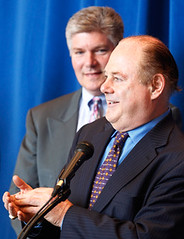 Stolen documents, military medals and other artifacts valued at about $5 million - including letters signed
by Abraham Lincoln and Thomas Jefferson - were returned Wednesday to Chicago's Polish Museum after being found in the basement of a home decades after they went missing.
Stolen documents, military medals and other artifacts valued at about $5 million - including letters signed
by Abraham Lincoln and Thomas Jefferson - were returned Wednesday to Chicago's Polish Museum after being found in the basement of a home decades after they went missing.
The more than 120 items, which were returned following an FBI investigation, include letters and documents dating to the 18th and 19th centuries, seals, military medals and Nazi propaganda from World War II. The pieces also included documentation about Napoleon, George Washington, John Adams and American Revolution hero Thaddeus Kosciuszko.
Museum president Maria Ciesla said she couldn't catch her breath when she received the phone call that the items, missing since the 1970s and 1980s, were located.
"This is something that we had dreamed and hoped for for so many years," Ciesla said. "It is so important for us to have this safely back not only for the rich Polish history but also for the wonderful American history. It is so important to the world stage."
Officials said Chicago coin and antiques dealer Harlan Berk notified the museum last October that his office had purchased historic items it had traced to the institution. The museum contacted the FBI, which started an investigation.
Berk told the FBI that the sellers said they found the artifacts in the basement of a Chicago house where they were tenants. FBI Art Crime Team investigators found that the residence was owned by the mother of a former Polish museum curator. The FBI recovered additional artifacts and documents from the home.
No charges were filed because the FBI couldn't determine who took the items from the museum or exactly when they were taken. The statute of limitations in the case also had run out.
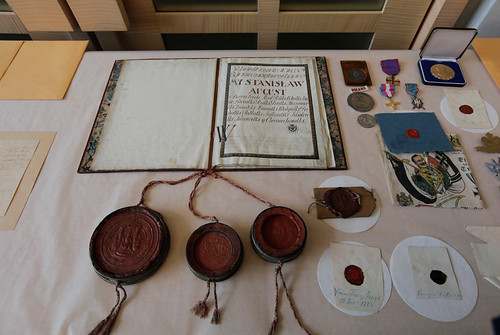
To read the complete article, see: $5 million in stolen documents and medals returned to Chicago's Polish museum (www.artdaily.org/index.asp?int_sec=2&int_new=56078)
ART AND VICTOR DAVID BRENNER TAKE ON TIMES SQUARE
Joel writes:
A pretty amazing venue. Art Takes Time Square was the themed competition and my "Inspiration of the Lincoln Cent" was chosen as one of the many artworks for display.
Here's the crowd viewing the work on one of the giant screens set up for the event.
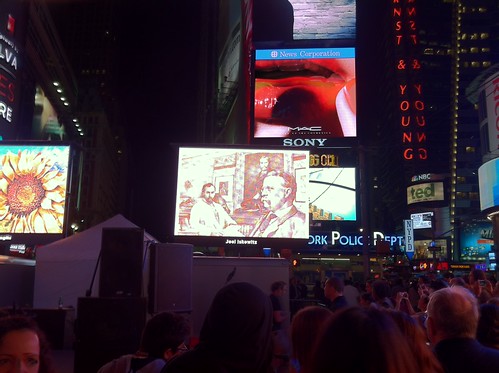
Here's a close up of Iskowitz' work
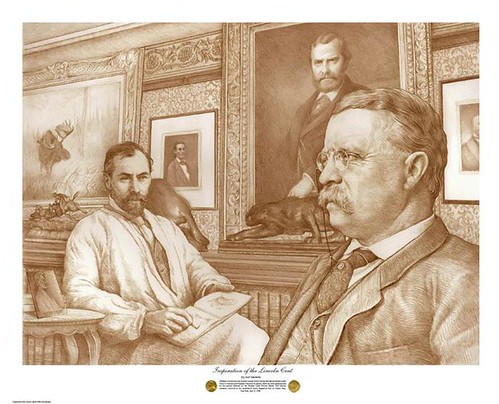
To read some articles on the event, see:
Web Sites Illuminate Unknown Artists
(www.nytimes.com/2012/06/18/arts/design/web-site-gives-artists-fame-in-times-square.html)
Times Square Billboards Answer a Higher Calling: Art
(www.capitalnewyork.com/article/culture/2012/06/6012774/times-square-billboards
-answer-high-brow-calling-art)
WHY CASH IS LOSING ITS CURRENCY
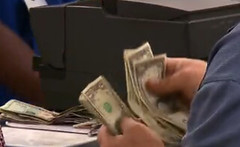 For generations now, storekeepers have been making change by taking bills and coins out of the cash register drawer. Now many experts say changing technology is nickel-and-diming old-fashioned cash out of existence. So is paper money a relic of a bygone era?
For generations now, storekeepers have been making change by taking bills and coins out of the cash register drawer. Now many experts say changing technology is nickel-and-diming old-fashioned cash out of existence. So is paper money a relic of a bygone era?
It's what the wallet was invented for, to carry cash. After all, there was a time when we needed cash everywhere we went, from filling stations to pay phones. Even the tooth fairy dealt only in cash.
But money isn't just physical anymore. It's not only the pennies in your piggy bank, or that raggedy dollar bill.
Money is also digital - it's zeros and ones stored in a computer, prompting some economists to predict the old-fashioned greenback may soon be a goner.
"There will be a time - I don't know when, I can't give you a date - when physical money is just going to cease to exist," said economist Robert Reich.
Economists like Reich say the demise of cash has been happening ever since our financial fortunes could first be told by a piece of plastic with a magnetic strip.
That was half a century ago - and now? "95 percent of the transactions in America, or more, have nothing to do with physical pieces of paper or coins," Reich said.
Think about it. Parking meters, taxis, tolls, even Girl Scout cookies don't require cash anymore, all proof (argue some) that cash's days are numbered.
"Twenty-two, thirty-two years from now, will cash still be here? I think we can put it in the grave already," said author David Wolman. In his new book, "The End of Money," he argues the biggest knock against cash is that it's costly.
To read the complete article, see: Why cash is losing its currency (www.cbsnews.com/8301-3445_162-57458886/why-cash-is-losing-its-currency/)
WAYNE'S NUMISMATIC DIARY: JUNE 24, 2012
Last week I promised to supply some images of items I exhibited at Nummis Nova, so here goes.
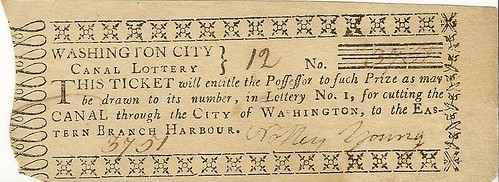
Washington City Canal Lottery ticket
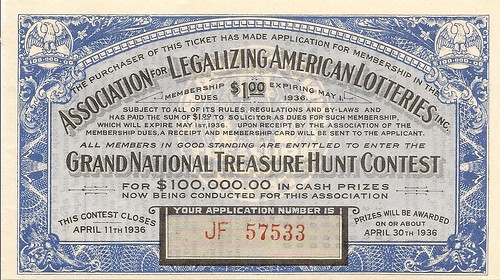
Association for Legalizing Lotteries ticket, 1936
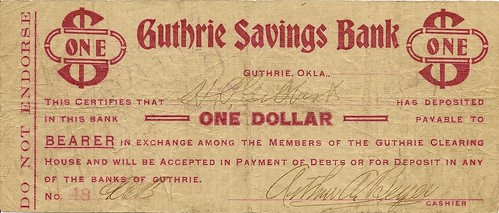
Guthrie Savings bank clearing house scrip
To read the earlier E-Sylum article, see: WAYNE'S NUMISMATIC DIARY: JUNE 17, 2012 (www.coinbooks.org/esylum_v15n25a13.html)
GOLD EXHIBITION AT LONDON'S GOLDSMITHS' HALL
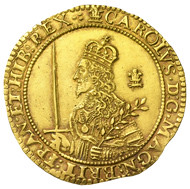 "Gold: Power and Allure" is the most comprehensive and ambitious exhibition ever staged at Goldsmiths' Hall. Until July 28th it powerfully tells the rich and previously untold story of Britain and its relationship with gold, demonstrating the country's unique golden heritage.
"Gold: Power and Allure" is the most comprehensive and ambitious exhibition ever staged at Goldsmiths' Hall. Until July 28th it powerfully tells the rich and previously untold story of Britain and its relationship with gold, demonstrating the country's unique golden heritage.
This major project showcases more than 400 gold items ranging in date from as early as 2500 BC to the present day. It includes rare and exquisite works of art, combining sophisticated artistry and skill, together with pieces of exceptional historic significance. Others are esoteric, curious and amusing. All the exhibits, displayed over three floors at Goldsmiths' Hall, have been loaned from distinguished institutions and private collections and many have rarely been seen in public before.
This is the first time such an extraordinary group of objects has been brought together. It tells a story of passion and power, fortunes lost and gained, and the special place this metal plays not only in our national, but also our personal histories.
Historian Dr Helen Clifford, the curator of the exhibition, explains: "Gold: Power and Allure presents the opportunity of a lifetime. The challenge has been to draw together the many strands that make a single precious metal so special and central to human society.
"With the focus on Britain it has been possible to assemble a story that goes far back into geological time and forward to the most cutting edge goldworking, where this country excels.
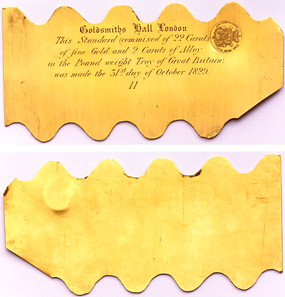
A so-called trial plate from 1649 to test the colour of the
freshly minted gold coins to ensure its correct composition.
"It reveals a story of the continuity of man's fascination with gold, from the Bronze Age to modern City finance, via a breathtaking range of more than four thousand years of work. In essence it is a story of global connections and one where the familiar is transmuted into the iconic, via the power of gold."
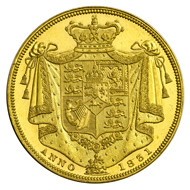 The influence and reach of the exhibition extends far beyond the boundaries of the City of London as a "Gold Trail" stretches across the breadth of the United Kingdom.
The influence and reach of the exhibition extends far beyond the boundaries of the City of London as a "Gold Trail" stretches across the breadth of the United Kingdom.
The "Gold Trail" charts every major gold collection and points of interest in regional museums, institutions and churches, both large and small collections and with varied uses. These include items too precious, fragile or large to be moved to Goldsmiths' Hall. Examples of places and items featured on the "Gold Trail" include the Gold Palm Room at Spencer House, the Royal Cornwall Museum, the Scottish Crown Jewels, St. Cuthbert's Cross, Durham, the Portland Gold Font and many, many more.
The exhibition will be accompanied by an associated book "Gold: Power and Allure" published by Paul Holberton.
To read the complete article, see: Gold Exhibition in London (www.coinsweekly.com/en/News/4?&id=1288)
QUERY: "IN GOOD NICK"
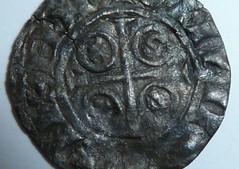 In a news article from England on the discovery of a buried coin of William the Conqueror, an archaeologist called the condition of the coin "quite good nick."
In a news article from England on the discovery of a buried coin of William the Conqueror, an archaeologist called the condition of the coin "quite good nick."
The complete paragraph was "Joanne Kirton, archaeology supervisor, added: "The coin is in quite good nick and it was very difficult to make out the name on the coin."
Maybe a British reader can translate the slang term "nick" in this meaning.
Here's the complete story: 1000-year-old coin found in Bamburgh (www.berwick-advertiser.co.uk/news/local-headlines/1000-year-old-coin-found-in-bamburgh-1-2366621)
THE BOOK BAZARRE
ALEKSEY NAVALNY'S RUSSIAN BANKNOTE STAMPS
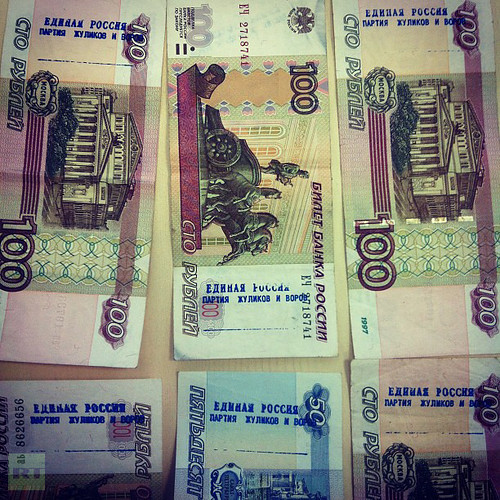
Russian blogger-cum-opposition leader Aleksey Navalny has called on his supporters to troll the authorities by stamping slogans on banknotes, suggesting that with due effort the medium could provide contact with each and every Russian citizen.
Navalny wrote in his blog that at first he considered political ads on the money little more than a joke - it seemed funny, but not very effective. However, after studying the statistics of banknote circulation he changed his mind.
With each bill changing hands from one to three times per day and with average lifespan from seven months to two years, a slogan stamped on a banknote will reach from 600 to 700 people on average, Navalny estimated.
But even with only 200 people reading the slogan, 100stamped bills will have an average audience of 20,000. Thus, if a group of 5,000 people stamped 100 bills each in just a year, the move would create enough stamped money so that each Russian citizen will have got hold of at least one.
Navalny illustrated his post with a picture of the money from his wallet - several 100-ruble notes with the slogan "United Russia is a party of crooks and thieves" stamped in blue ink on the white section. The slogan is Navalny's personal creation, coined in early 2011.
The slogan has caused one United Russia member to sue Navalny over damage to his reputation, but the court ruled in favor of the blogger as the latter carefully presented the definition as his personal opinion and estimation.
In his most recent post urging the currency action, the blogger also wrote that his suggested type of propaganda was cheap, relatively effective and absolutely legal.
As for that last definition, it should be noted that in 2011 Russian police launched a criminal case against a man on the Far Eastern island of Sakhalin for a very similar offence - the man wrote slogans on banknotes. In this case, however, the slogans were written by hand and police said they were extremist in nature, though they never provided a single example.
To read the complete article, see: Banknote stamp stunt: Viral cash campaign targets 'crooks & thieves' (rt.com/politics/money-make-protest-106/)
WHERE MONEY GOES TO DIE
 A lot of businesses want to attract "old money."
A lot of businesses want to attract "old money."
Ford is no exception - only it's more interested in the shredded-up variety than in the kind that belongs to a fancy country club.
Stepping up its efforts to curb the use of petroleum-based products, the automaker announced last month that it's attempting to use old U.S. cash to make trays and bins for its vehicles. Ford (F: 10.56, +0.22, +2.13%) already employs a range of alternative materials in the manufacturing of its products, including plastic bottles to make seat fabric and denim to muffle sound. The company is looking at ways to incorporate dandelions, coconuts and sugarcane into future vehicle parts as well.
But U.S. paper currency is arguably the most interesting ingredient in Ford's recipe book. After all, it's hard to imagine that there's a supply of old bills that exists outside of a collector's safe or government vault - and if there is, that it isn't serving some lofty purpose.
The reality is that old cash abounds, and with almost nowhere to go but the landfill.
Because it's 75% cotton and 25% linen, currency paper is more durable than everyday paper, which is made mostly of wood pulp. It can withstand a lot of wear and tear - the U.S. Bureau of Engraving and Printing estimates that it takes about 4,000 double folds (meaning one fold forward and one fold back) to rip a bill.
Still, bills do eventually wear out. Bills of smaller denominations tend to age the fastest, as they're passed around more frequently than those of larger denominations. The Federal Reserve estimates that the average $1 bill lasts 4.8 years, while $5 and $10 bills last 3.8 years and 3.6 years, respectively. On the higher end of the spectrum, the average $20 bill lasts 6.7 years, while $50 bills and $100 bills last 9.6 years and 17.9 years, respectively.
The majority of bills that are too worn for circulation are shredded by the Federal Reserve Banks and sent to landfills. The Fed generated a total of about 5,300 tons of shredded paper currency in 2011, according to a spokesperson.
To read the complete article, see:
Where Money Goes to Die
(www.foxbusiness.com/personal-finance/2012/05/03/where-money
-goes-to-die/?intcmp=featuredmedia)
SOME NEW COIN DESIGNS: LITHUANIA AND SLOVAKIA
 The Board of the Bank of Lithuania decided to declare the 10 litas commemorative coin dedicated to Fine Arts as legal tender and issue it into circulation on 26 June 2012, the Bank of Lithuania said in a statement.
The Board of the Bank of Lithuania decided to declare the 10 litas commemorative coin dedicated to Fine Arts as legal tender and issue it into circulation on 26 June 2012, the Bank of Lithuania said in a statement.
The graphic design for the coin was created by Ruta Nicajiene, whereas the plaster model was made by Giedrius Paulauskis. The coins are minted by company Lietuvos monetų kalykla (Lithuanian Mint), reports LETA/ELTA.
It will be already the third coin from the series Lithuanian Culture. The first coin, which was dedicated to Music, was issued in 2010, whereas the second coin, which was dedicated to Theatre, was issued in 2011.
To read the complete article, see: Lithuanian coin dedicated to Fine Arts to be issued into circulation in June (www.baltic-course.com/eng/finances/?doc=58743)
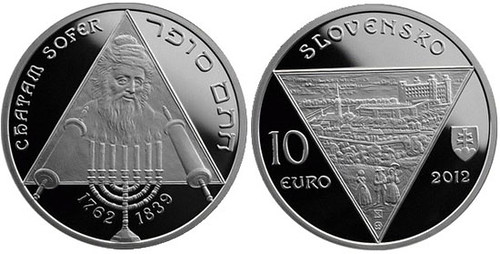
The National Bank of Slovakia has issued a new coin which marks the 250th anniversary of birth of Chatam Sofer (1762 - 1839) one of Europe's most noted scholars of the Talmud and founder of the Bratislava Yeshiva which continued as a primary institute of Hebrew education until the outbreak of World War II. Born in Frankfurt, Sofer traveled to Boskovice, Moravia (now part of the Czech Republic) as a scholar in 1782 where he became recognized as an authority in the teachings of the Talmud. The Yeshiva he founded in Bratislava in 1806 eventually became the most influential institute of Hebrew studies.
SCHOLARS FEAR LAWSUITS IN DECLARING WORKS REAL OR FAKE
John Elderfield, former chief curator of painting and sculpture at the Museum of Modern Art, remembers the days when scholars spoke freely about whether a particular work was genuine.
They were connoisseurs, this was their field of expertise, and a curator like Kirk Varnedoe, Mr. Elderfield's predecessor at the Modern, would think nothing of offering his view of a drawing attributed to Rodin, his specialty.
"He was qualified to do it and felt he had a moral obligation to do it," Mr. Elderfield said.
But when the owner of a painting attributed to Henri Matisse recently asked Mr. Elderfield for his opinion, he demurred. He worried he could be sued if he said the painting was not a real Matisse.
Mr. Elderfield is hardly alone in feeling that art's celebrated freedom of expression no longer extends to expert opinions on authenticity. As spectacular sums flow through the art market and an expert verdict can make or destroy a fortune, several high-profile legal cases have pushed scholars to censor themselves for fear of becoming entangled in lawsuits.
The Andy Warhol Foundation for the Visual Arts, the Roy Lichtenstein Foundation and the Noguchi Museum have all stopped authenticating works to avoid litigation. In January the Courtauld Institute of Art in London cited "the possibility of legal action" when it canceled a forum discussing a controversial set of some 600 drawings attributed to Francis Bacon. And the leading experts on Degas have avoided publicly saying whether 74 plasters attributed to him are a stupendous new find or an elaborate hoax.
The anxiety has even touched the supreme arbiter of the genuine and fake: the catalogue raisonné, the definitive, scholarly compendium of an artist's work. Inclusion has been called the difference between "great wealth and the gutter," and auction houses sometimes refuse to handle unlisted works. As a result catalogue raisonné authors have been the targets of lawsuits, not to mention bribes and even death threats.
"Legal cage rattling was always part of the process," said Nancy Mowll Mathews, president of the Catalogue Raisonné Scholars Association. But the staggering rise in art prices has transformed the cost-benefit analysis of suing at the same time that fraud has become more profitable, she said.
Fears of being sued may even lead to changes in the nature of catalogues raisonnés, Ms. Flescher added. She pointed to recent decisions by the Calder and Lichtenstein foundations and the Noguchi Museum to move their cataloging efforts online and label them as "works in progress."
"What we are presenting is a combination of completed research and research pending," said Shaina D. Larrivee, project manager of the Isamu Noguchi catalogue raisonné. "We are very clear that 'research pending' does not guarantee inclusion in the final catalogue raisonné, and that we have the ability to remove artworks if new information comes to light."
To read the complete article, see:
In Art, Freedom of Expression Doesn't Extend to ‘Is It Real?'
(www.nytimes.com/2012/06/20/arts/design/art-scholars-fear-lawsuits
-in-declaring-works-real-or-fake.html)
BULGARIAN ARCHAEOLOGISTS DISCOVER BRONZE COIN TREASURE
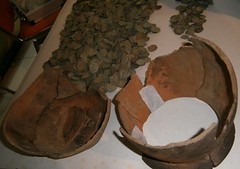 Bulgarian archaeologists have discovered a treasure of bronze coins during excavations in the Black Sea resort town of Sozopol.
Bulgarian archaeologists have discovered a treasure of bronze coins during excavations in the Black Sea resort town of Sozopol.
The treasure was found hidden in a small jar, and consists of 225 Ancient Greek bronze coins, explained the leader of the archaeological team, Prof. Krastina Panayotova, as cited by the Focus news agency.
The coins are well-preserved, and were minted in Sozopol in the 4th century; they were found during excavations of a necropolis in the Budzhaka area close to the Black Sea town, she explained.
"They were not found in a grave, they are not part of a funeral, this is a treasure, a "classical" case of buried treasure. We have never found a buried treasure before. I have been dealing with Apollonia (Sozopol's Ancient Greek name - editor's note) for 25 years, and have never seen anything like this. It is very rare to come across such a find in a necropolis," Prof. Panayotova explained.
She said she knows of one more case in which a vessel with coins was found in a necropolis in Romania but the treasure found in the necropolis near Sozopol is a precedent for Bulgaria.
To read the complete article, see: Bulgarian Archaeologists Stumble Upon Ancient Treasure in Sozopol (www.novinite.com/view_news.php?id=140509)
FEATURED WEB PAGE: COINS OF ALBANIA
This week's Featured Web Page is on the coins of Albania.

commons.wikimedia.org/wiki/Category:Coins_of_Albania
